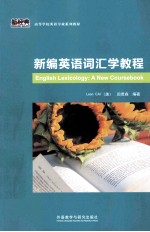图书介绍
新编英语词汇学教程pdf电子书版本下载

- (美)蔡增亮,田贵森编著 著
- 出版社: 北京:外语教学与研究出版社
- ISBN:9787513535953
- 出版时间:2013
- 标注页数:278页
- 文件大小:90MB
- 文件页数:288页
- 主题词:英语-词汇学-高等学校-教材
PDF下载
下载说明
新编英语词汇学教程PDF格式电子书版下载
下载的文件为RAR压缩包。需要使用解压软件进行解压得到PDF格式图书。建议使用BT下载工具Free Download Manager进行下载,简称FDM(免费,没有广告,支持多平台)。本站资源全部打包为BT种子。所以需要使用专业的BT下载软件进行下载。如 BitComet qBittorrent uTorrent等BT下载工具。迅雷目前由于本站不是热门资源。不推荐使用!后期资源热门了。安装了迅雷也可以迅雷进行下载!
(文件页数 要大于 标注页数,上中下等多册电子书除外)
注意:本站所有压缩包均有解压码: 点击下载压缩包解压工具
图书目录
Chapter 1 INTRODUCING LEXICOLOGY 1
1.1 The Scope of Lexicology 2
1.2 The Significance of Studying Vocabulary 3
1.3 Lexicology and Linguistic Studies 6
1.4 Research Methods in Lexicology 9
1.5 Questions for Further Study 12
Chapter 2 THE SOURCES AND DEVELOPMENT OF ENGLISH VOCABULARY 13
2.1 The Origins of English Words 14
2.2 The Influences of Foreign Languages 15
2.3 The Formation of English Words 17
2.4 The Characteristics of Modern English Vocabulary 21
2.5 Questions for Further Study 24
Chapter 3 THE FORMS AND STRUCTURES OF ENGLISH WORDS 27
3.1 Morphological Structures of English Words 29
3.2 Morphemes 29
3.3 Roots 32
3.4 Questions for Further Study 39
Chapter 4 WORD FORMATION VIA AFFIXATION 41
4.1 Lexical Prefixes 42
4.2 Grammatical Prefixes 62
4.3 Lexical Suffixes 64
4.4 Grammatical Suffixes 81
4.5 Questions for Further Study 93
Chapter 5 WORD FORMATION VIA COMPOUNDING 95
5.1 Three Forms of Compounds 96
5.2 Structures of Compounds 98
5.3 Functions of Compounds 101
5.4 Characteristics of Compounds 101
5.5 Compound Nouns 102
5.6 Compound Adjectives 109
5.7 Phrasal Compounds 113
5.8 Questions for Further Study 115
Chapter 6 WORD FORMATION VIA OTHER METHODS 117
6.1 Blending 118
6.2 Conversion 119
6.3 Borrowing 120
6.4 Clipping 127
6.5 Acronymy and Initialism 128
6.6 Questions for Further Study 132
Chapter 7 SENSE RELATIONS 133
7.1 Types of Meaning 134
7.2 Sense Relations 136
7.3 Polysemy 139
7.4 Homonymy 142
7.5 Questions for Further Study 146
Chapter 8 FIGURATIVE LANGUAGE 147
8.1 Simile 148
8.2 Metaphor 150
8.3 Personification 152
8.4 Dehumanization 153
8.5 Hyperbole 154
8.6 Allusion 155
8.7 Paradox 156
8.8 Onomatopoeia 157
8.9 Questions for Further Study 160
Chapter 9 LANGUAGE VARIATION AND WORD CHOICE 163
9.1 Speakers'/Writers'Choice of Words 165
9.2 Word Choice for Formal English 167
9.3 Words to Avoid in Formal English 185
9.4 Questions for Further Study 187
Chapter 10 COLLOCATIONS 189
10.1 Noun Collocations 190
10.2 Verb Collocations 193
10.3 Adjective Collocations 198
10.4 Adverb Collocations 200
10.5 Preposition Collocations 204
10.6 Conjunction Collocations 207
10.7 Questions for Further Study 209
Chapter 11 DICTIONARIES AND VOCABULARY LEARNING 211
11.1 Types of Dictionaries 212
11.2 Information in Dictionaries 215
11.3 Monolingual and Bilingual Dictionaries 216
11.4 Principles of Selecting a Dictionary 217
11.5 Questions for Further Study 219
Chapter 12 ENGLISH VOCABULARY LEARNING STRATEGIES 221
12.1 Classifications of Vocabulary Learning Strategies 223
12.2 Suggested Methods in Learning Vocabulary 226
12.3 Questions for Further Study 231
Appendix Ⅰ A SELECTED LIST OF ENGLISH PREFIXES 233
Appendix Ⅱ A SELECTED LIST OF ENGLISH SU FFIXES 237
Appendix Ⅲ A SELECTED LIST OF ENGLISH COMBINING FORMS 242
Appendix Ⅳ A SELECTED LIST OF ENGLISH WORD ROOTS 249
Bibliography 253
Suggested Answers 255